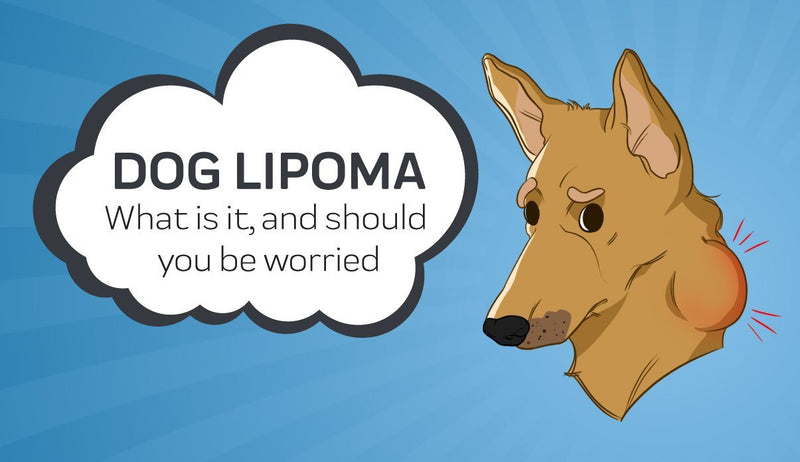- What is a Lipoma?
- Characteristics of Lipomas In Dogs
- Causes of Lipoma In Dogs
- Dogs Prone to Lipomas
- Metabolism and Lipoma
- Diagnosing and Treating Lipomas
- Surgically Removing the Tumor
- Conclusion
During the time that you spend with your dog, you will see the contract and overcome a variety of different ailments. Similar to humans, dogs manage to overcome minor ailments, like a minor cold or a small scrape or bruise but require help with other more serious diseases.
So as their owner, you have to take very serious precautions and must learn to recognize every small difference and nuance of your four-legged friend.
Most dog owners can relate to the fact that there is a multitude of diseases that pass right beneath their radar, which could possibly be very dangerous for their health. One such disease that often doesn’t get the attention of pet owners is dog lipoma. One of the major reasons dog owners are not able to recognize a dog's lipoma is because of their lack of knowledge on the subject matter.
The worrying thing about dog lipomas is that they are very common among all types of dogs and it does not discriminate between breeds. A lipoma can occur at various points of your canine’s body; so, it is not uncommon for a pet owner to not be able to notice a lipoma.
In this guide, you will learn everything that you need to know about the lipomas in dogs and how they can affect their well-being. This guide will go over all of the various factors that you must consider while treating it, the symptoms, causes, and the best way to treat the ailment itself.
After reading this guide you will be able to tell the difference between a lipoma and any other type of infection, and you will be more ready to handle such a situation if it ever happens again.

What is a Lipoma?
While reading this, you might have been wondering, “What is a lipoma anyway?” A lipoma is a collection of fatty cells and tissue under the skin of your four-legged friend and takes the form of a small bump or lump. In other words, a lipoma is a soft and squishy bump on the skin of your dog that can make for a very unappealing, yet somewhat benign bump on your canine.
It is the most common form of non-cancerous fatty tumors and is almost harmless in its initial stages. While you may not be able to notice the fatty tumor in its initial stages, at a certain point they will grow to a very large size.
Although they grow at a very slow rate, by the second or third week of this ailment you will be able to notice a relatively big bump on your dog’s skin.
A dog lipoma, by itself, poses no serious threat to your dog or their livelihood; yet it is important that you are able to recognize a lipoma, so that you may not confuse it with a fatty tumor and put the potential well being of your dog at risk.
Seeing how lipomas are a very common form of tumors in senior dogs, it is very important that you are able to differentiate between these different fatty tumors as they can adversely affect the well-being of your canine.
Lipomas are very common among various dogs that exceed a certain age, and these dogs will develop at least one during their lifetime. That being said, just because a lipoma is potentially harmless to your dog it does not mean that you can disregard it altogether.
Seeing how large a lipoma can grow, you must at least be curious about this growth on the body of your dog.
Characteristics of Lipomas In Dogs
Lipomas are incredibly squishy and sensitive to touch and grow on various places on the skin of your canine. The most famous places for lipomas to develop are underarms, arms, and torso. Various veterinarians and dermatologists have recognized a certain pattern with lipomas and have seen that most lipomas tend to develop around this area.
One of the most noticeable characteristics of lipoma is that they are incredibly soft to the touch and they will often press into the skin. Moreover, they are incredibly mobile and can move around the skin if you try.
Nevertheless, there are two types of lipomas; one that comes under the skin and the other that grows into the muscle or tissue. Lipomas that grow into the muscle or tissue are strangely very tough and are hard to touch. They do not even move if you try to move them in a certain direction. A muscle-based lipoma is possibly more concerning than its counterpart, as it resembles fatty tumors.
Lipomas have a fair amount of other characteristics that can help you identify and differentiate them from other types of tumors. Another one of its most important characteristics is that lipomas, as compared to other tumors, grow incredibly slowly. Compared to other tumors, lipomas grow at a snail’s pace, which makes it easier to differentiate.
As surprising as it might seem, while these lipomas are not inherently dangerous, they often come in large numbers. This means that it is possible for your dog to have at least three or four lipomas at the same time.
Furthermore, seeing how these - on their own – do not cause any harm to the dog’s body, the only time that your canine will pay attention to a lipoma is when it grows in a place where it can restrict or obstruct movement. This can be somewhat painful for your four-legged friend and make the process of simply walking just that much more tiring.
The average size of a lipoma is between one and three cm, making them fairly recognizable on their own.
Now that you understand what a lipoma is and what are its different characteristics, let’s move onto the causes for this certain situation and why do dogs contract lipoma in the first place.
Causes of Lipoma In Dogs
Here we will discuss all of the possible reasons why your dog may contract lipoma or the factors that could possibly lead to it. This will give you a better understanding of the overall situation that your dog is in, and will help reduce the chances of this happening again.
Various studies show that veterinarians treat nearly 1.7 million dogs with lipoma every year, which is only in the case of dogs. This number is only for lipomas and does not count all of the other lumps and bumps that your dog may contract. As your dog tends to get older, it will develop more lipomas.
While a healthy body tends to rid itself of any potential threats and toxins through various processes, sometimes the body tends to rid itself of toxins through the skin. Normally the body rids toxins through organs, such as the kidneys, liver, and intestines, but when the body is not able to rid toxins from the usual organs, it will try to release these toxins through the skin.
Lipomas are the result of your body trying to relieve itself of toxins, but it cannot do so through regular channels. Regardless of the cause of a lipoma, the most basic reason why this happens to them is that their organs are not functioning optimally.
With this in mind, here are a few of the most famous reasons why you dog may have a lipoma.
Environmental Toxins
To say that the environment that your dog lives in is important would be an understatement. It is very possible that your dog might have been subject to an allergic or toxic environment, and it led to them develop a lipoma.
Toxins like insecticides and pesticides are incredibly dangerous for your dog, yet they are very common in all neighborhoods. If you happen to use insecticides in your home, be sure to keep your dog away from the infected locations.
Even if your dog happens to pass by a place that has toxins in abundance, you can keep them from developing a lipoma by simply washing them or by washing their paws. Seeing how it is at times impossible for your dog to avoid pesticides or insecticides, by simply washing them or giving them a nice bath, you can solve most of your problems.
Medicines or other Chemicals
As dogs get older they are introduced to various types of medicines, most of which they don’t like. One of the major side effects of all these types of medicines is that they can sometimes lead to a lipoma.
Medicines that you feed your dog for their flea, ticks, and heartworms are incredibly toxic, not just to the insects, but to your canine as well. You must discuss this certain dilemma with your veterinarian and ask them what the best possible course of action is. You can also introduce your four-legged companion to a multitude of natural alternatives for fleas and ticks. There are a plethora of natural alternatives that can help you keep your dog safe from a variety of different diseases. Not only are these natural alternatives incredibly safe, but at times are also more effective than their antibiotic counterparts.
Poor Diet

While they may eat anything that you give them in respect and love for you, their stomach cannot handle certain foods and it is often the reason for a variety of different problems and discomfort. It's important that you incorporate normal nutrients, vitamins, and minerals that are all essential for a healthy diet. If you were to receive a penny for every time that a veterinarian told you that the current disease that your dog is suffering from is because of their diet, you would probably be rich. For most dogs that have a brute stature, all dogs in general, are incredibly sensitive about what they eat.
Their diet can be one of the main contributors to the lipoma problem that they may be facing. Any processed food has a variety of carbohydrates and toxins and can possibly contribute to the development of a lipoma as those negative agents will store in fat cells. A vast majority of overweight dogs seem to develop these lumps which leads to this conclusion.
As a pet owner you should also be careful of the water that you give to your companion as it can weaken their thyroid endocrine system. Chlorine that is often found in tap water can greatly harm your dog’s health, which is why you should always give them filtered water.
Dogs Prone to Lipomas
Much like a lick granuloma a lipoma does not discriminate between breeds, age, or sex and can affect any pup at any given time. This is further proof as most veterinarians firmly believe that typically, lipomas do not discriminate between breeds, as they have treated nearly every dog for a lipoma.
Although lipomas do not discriminate, older pups are always at a greater risk of developing a lipoma, mostly in part because of their comparatively weaker organs.
While it may be the case that most dogs are not prone to lipomas, many veterinarians believe that metabolism and lipomas have some sort of connection. Understanding this connection will bring us a step closer to avoiding the risk of lipomas in your canine’s body.
Metabolism and Lipoma
Various veterinarians believe that the risk that your dog will develop a lipoma directly correlates to the ability of your pup’s body to metabolize fat. This is apparent as lipomas, both big and plentiful, are common among dogs that are fat, skinny, or neutered. Overweight Dogs that have less active metabolism are more susceptible to lipomas, as their body is not able to metabolize fat properly which makes them more vulnerable to lipomas.
While it is true that a lipoma is not something to be worried about as it is benign and does not inherently cause serious damage, you must still ensure that the lipoma does not grow faster than expected as it can be a sign of something much more serious like malignant masses like liposarcomas.
Diagnosing and Treating Lipomas
As simple as it may seem, diagnosing a lipoma can be quite a challenge for a veterinarian. Seeing how most lipomas can possibly be cancerous, veterinarians leave no stone unturned when it comes to their treatment. There is a multitude of different steps that a veterinarian takes in order to ensure that the lipoma that your dog has is not one that can potentially be harmful to them. Most of the time, if your veterinarian finds that the tumor that they have is not cancerous, they will advise against removing it as it can possibly cause damage to the well being of your four-legged companions.
In order to diagnose the tumor, the veterinarian will resort to one of the three or all three procedures. All of these procedures will check to see whether or not your dog has a cancerous tumor or not. The first of these checks will be a fine needle aspirate, where the veterinarian will insert a fine needle into the lump and collect a sample of the mass to be tested.
It is a form of biopsy which will help them study the sample and rule out the risk of cancer. It is a very safe procedure and there have never been any life-threatening complications to any animal.
Once the veterinarian performs fine needle aspiration and collects their tissue they will do a microscopic evaluation of the cells which will help them build a proper case for the lipoma and ensure that this tumor is not a cancerous one. Their next course of action depends on the type of tumor that your dog may have.
Surgically Removing the Tumor
Once the veterinarian tells you of the type of tumor your dog has, people often think that the next step is to surgically remove it, which is not the case. A veterinarian only suggests that you remove the tumor if it is affecting your dog in any way other than their appearance.
So, if the tumor is cancerous, they will definitely remove it; however, if the tumor is not cancerous and is not actively obstructing the way your dog moves or how they function, your veterinarian often advises against surgically removing it.
Another reason why a veterinarian may advise removing the tumor is when your dog is obsessively licking the area that is affected. The obsessive licking of the area affected by a lipoma can lead to bruising and a slew of different mental disorders. So, in order for you your canine to avoid hurting themselves, the veterinarian may suggest surgically removing the tumor.
With all of this talk about surgical removal, you may be thinking about what the price of this operation may be. Depending on the type of operation that is necessary for your companion, it can range from $200 to $1000. Easy surgical removals often cost between $300 and $500, whereas a more challenging or extensive operation can cost $1000.
Conclusion
Although Dog lipomas are benign and not inherently harmful for your canine, it is still not something that you can take lightly as it can result in a harmful and cancerous tumor. Best practice is to keep and eye on it's growth and how fast it grows and keep in contact with your vet to monitor this situation.

















Hello Patricia,
Thank you for taking the time to read our blog. We a happy to hear you enjoyed learning about lipoma.
My cocker spaniel has Lipoma. I now have a better understanding what causes Lipoma.